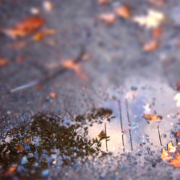Capturing the First Flush of Rainwater
The most important water to capture in your landscape is the first inch of rainfall after a dry spell. This is called the “first flush.”
Rainfall in dry climates like the San Diego region is often a “first flush” repeatedly due to long stretches between rainy periods.
The first rainfall washes away pollutants that have gathered on hard surfaces since the last rain. It needs to be filtered as much as possible by landscaping before it goes anywhere else, especially into storm drains that empty into the oceans.
How much water comes off your roof?
The shape of your roof doesn’t make any difference. The same amount of water falls on the roof whether sloped or flat. Measure a sloped roof either using an aerial view or from the ground without worrying about the slope itself. Just measure the outside edges the same way you would if it was flat, and calculate the square footage.
Flat roofs covering a building in one contiguous shape are easier to measure. Some roofs are more complicated. Divide this type of roof into individual squares or triangles. Measure each one at a time, then add the figures together for your total roof area.
Calculate your potential water capture
Once you know the total roof area, you can determine the amount of rainfall it generates in gallons, then use the following formula to convert square feet to gallons.
Formula: Rainfall in Inches x Total Square Feet x 0.62 = Gallons of Rainwater From the Roof
Example using a 1,000 square foot roof: 1 inch of rain x 1000 x 0.62 = 620 gallons.
San Diego’s rainfall total for “water year” 2018 was about 3.3 inches. Imagine this amount falling on a 1,000 square-foot roof. The total amount of water runoff during this water year would be 3.3 X 1000 X 0.62 = 2,046 gallons.
Even in our dry climate, this rainfall adds up to a lot of water runoff. It’s easy to see how important it is to save as much of this water as possible in a landscape designed to be a sponge instead of a brick.
This article was inspired by the 71-page Sustainable Landscapes Program guidebook available at SustainableLandscapesSD.org. The Water Authority and its partners also offer other great resources for landscaping upgrades, including free WaterSmart classes at WaterSmartSD.org.



